Water Access
Benefits of Drinking Water
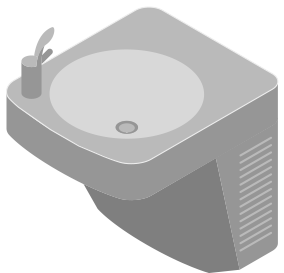
Providing access to drinking water gives students a healthy alternative to sugar-sweetened beverages. It helps to increase students’ overall water consumption, maintain hydration, and reduce energy intake if substituted for sugar-sweetened beverages.1-3 Adequate hydration also may improve cognitive function in children and adolescents.4-8 Drinking water, if fluoridated, also plays a role in preventing dental caries (cavities).
Access to Drinking Water
![]()
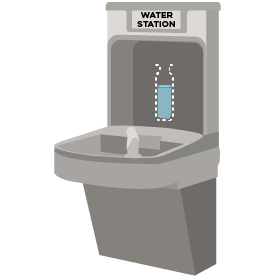 The Healthy, Hunger-Free Kids Act of 2010 requires schools participating in the National School Lunch Program (NSLP) to make free water available to students during meal times where they are served. The standards also require schools in the School Breakfast Program (SBP) to make drinking water available when breakfast is served in the cafeteria.
The Healthy, Hunger-Free Kids Act of 2010 requires schools participating in the National School Lunch Program (NSLP) to make free water available to students during meal times where they are served. The standards also require schools in the School Breakfast Program (SBP) to make drinking water available when breakfast is served in the cafeteria.
In addition to the requirements, schools should use a variety of strategies to
- Ensure that water fountains are clean and properly maintained
- Provide access to water fountains, dispensers, and hydration stations throughout the school
- Allow students to have water bottles in class or to go to the water fountain if they need to drink water
US Environmental Protection Agency (EPA) standards and regulations assure that tap water is clean and safe. In rare cases when tap water may not be safe to drink, schools should provide drinking water to students in other ways, including installing filtration systems or purchasing drinking water.
Key Resources
- EPA Drinking Water in Schools & Child Care Facilities
- USDA Water Availability During National School Lunch Program Meal Service
- USDA Resources for Making Potable Water Available in Schools and Child Care Facilities
- Water Access in Schools: Model Wellness Policy Language [PDF – 1.53MB]
- Managing Lead in Drinking Water at Schools and Early Childhood Education Facilities
- National Drinking Water Alliance
- CDC Plain Water, the Healthier Choice
- CDC Water and Nutrition
- Keep It Flowing: A Practical Guide to School Drinking Water Planning, Maintenance & Repair [PDF – 1MB]
- Parents Making Waves: A Parent Toolkit for Promoting Drinking Water in Schools
- Nutrition and Obesity Policy Research and Evaluation Network (NOPREN) Water Access Working Group
Increasing Access to Drinking Water in Schools
Increasing Access to Drinking Water in Schools [PDF – 150 KB] provides school health councils, nutrition services providers, principals, teachers, parents, and other school staff with information and tools to
- Meet free drinking water requirements in National School Lunch Program (NSLP) and School Breakfast Program (SBP) programs.
- Help make clean, free drinking water readily available throughout multiple points in school settings.
- Promote water consumption as a healthy beverage.
The easy-to-use tool kit includes background information, needs assessment tools, implementation strategies, and evaluation guidance to provide students with access to drinking water as part of a healthy nutrition environment.
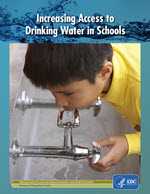
Increasing Access to Drinking Water in Schools
[PDF – 150 KB]
Background [PDF – 290 KB]
Conduct a Needs Assessment [PDF – 373 KB]
Develop a Plan [PDF – 201 KB]
Put the Plan Into Action [PDF – 404 KB]
Evaluate Progress [PDF – 174 KB]
Appendix 1: School Drinking Water Needs Assessment Checklist and Planning Guide (Fillable PDF template) [PDF – 443 KB]
Appendix 2: Diagram of Water Testing in Schools [PDF – 40 KB]
Appendix 3: Examples of Water Dispensers for Schools [PDF – 68 KB]
Appendix 4: Strategies to Overcome Potential Challenges [PDF – 37 KB]
Appendix 5: Water Access Key Stakeholder Interview Questions [PDF – 136 KB]
This presentation describes how to use the Increasing Access to Drinking Water in Schools Tool Kit to help schools meet federal drinking water requirements for school meal programs and help make clean, free drinking water readily available throughout the school setting.
Increasing Access to Drinking Water in Schools Tool Kit: Step by Step Guidance on Using the Tool Kit
[PDF – 2.32 MB] [PPT – 12.7 MB]
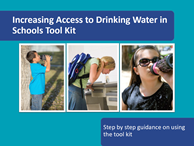
References (expand to view)
- Kaushik A, Mullee MA, Bryant TN, Hill CM. A study of the association between children’s access to drinking water in primary schools and their fluid intake: can water be ‘cool’ in school? Child: Care, Health & Development. 2007;33:409–15.
- Muckelbauer R, Libuda L, Clausen K, Toschke AM, Reinehr T, Kersting M. Promotion and provision of drinking water in schools for overweight prevention: randomized, controlled cluster trial. Pediatrics. 2009;123:e661–e667.
- Wang Y C, Ludwig DS, Sonneville K, Gortmaker SL. Impact of change in sweetened caloric beverage consumption on energy intake among children and adolescents. Archieves of Pediatric & Adolescent Medicine. 2009;163(4):336–343.
- Popkin BM, D’Anci KE, Rosenberg IH. Water, hydration, and health. Nutrition Reviews. 2010;68(8):439–458.
- Kempton MJ, Ettinger U, Foster R, Williams SCR, Calvert GA, Hampshire A, et al. Dehydration affects brain structure and function in healthy adolescents. Human Brain Mapping. 2011;32:71–79.
- Edmonds CJ, Jeffes B. Does having a drink help you think? 6 to 7-year-old children show improvements in cognitive performance from baseline to test after having a drink of water. Appetite. 2009;53:469–472.
- Edmonds CJ, Burford D. Should children drink more water? The effects of drinking water on cognition in children. Appetite. 2009;52:776–779.
- Benton D, Burgess N. The effect of the consumption of water on the memory and attention of children. Appetite. 2009;53:143–146.
- Page last reviewed: May 16, 2017
- Page last updated: May 16, 2017
- Content source:


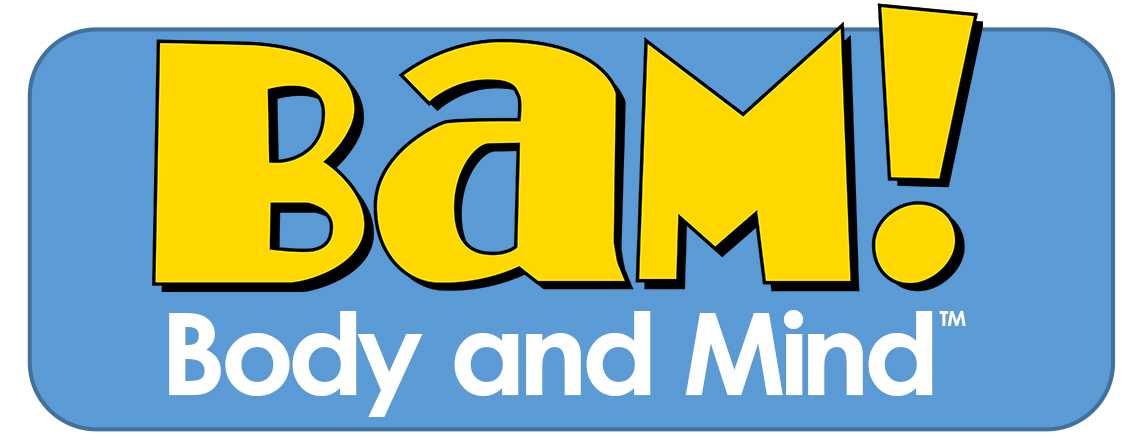
 ShareCompartir
ShareCompartir